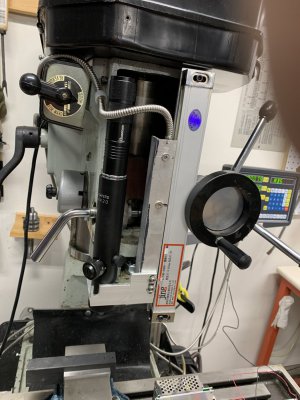I have an older round column mill. As anyone with one of these is aware your OK until you need to move the head. Getting it back on the same axis point can be a challenge, Best solution I can think of is an autocollimator down the middle of the spindle. Rudely accurate and expensive at best, also kind of defeating should you need to put the chuck/collet back in. Lasers really don't work that well. They are ok if you want to be within a fortnight as the beam size changes with distance and the beams seem to large to start with.
What I found that works very well is a cheap, (got mine from a gun dealer that had replaced a customers 4X10 gun scope because the hermitic seal failed and could no longer be used outside in bad weather.) A gun scope, one that is short, mine is about 5" long. If you shine a light thru the eye end it will project the crosshairs onto a distance surface. I tried this out across my garage, about 20 feet. Built a rather crude optical rail and as I moved the assembly across the garage the crosshair size remained very close to the original size. I then mounted an LED in place of the flashlight I was using so that angel would not change.
Next I built a mount and put it on the front of the mill head. I aligned it parallel to the spindle. to do this I took a piece of scrap material mounted it in my vice drilled and reamed a hole, Made a pin of the same size for a slip fit. Position the head so at mid stroke the pin was engaged with the hole about 1" deep. Marked a spot on my bed. Moved the head to a random position and lowered it, aligned the cross hairs with my mark, Locked it in place. Ran the spindle up and down to check fit. Adjusted the scope to be closer to parallel. Repeated this until I got a good fit. I was now close to parallel. Raised the head to max. repeated the procedure and adj. A few time up and down until I felt comfortable with the parallelism.
Lock the scope in place and it has been working like a charm, until you move the scope that is.
I suspect this COULD give you Micron resolution, if you played with it enough. But I am using a round column mill so expecting that is kind of silly.
b


